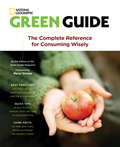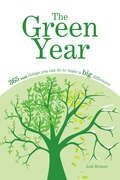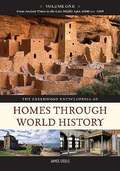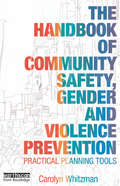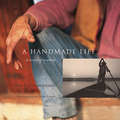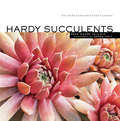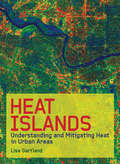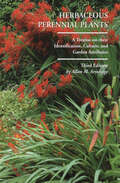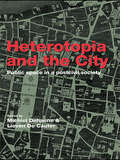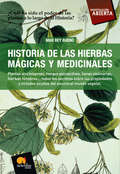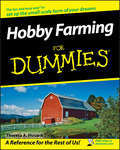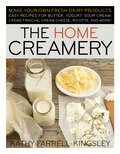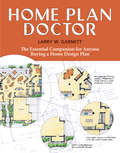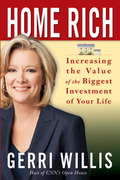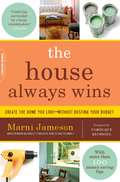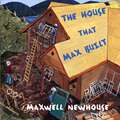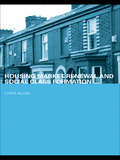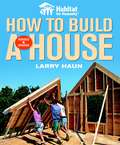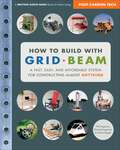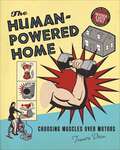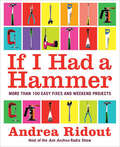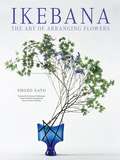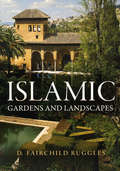- Table View
- List View
Green Guide: The Complete Reference for Consuming Wisely
by Editors of Green GuidePaper or plastic? Organic or conventional? In a world that is rapidly going "green," how does the average person make decisions that are smart for the family-and good for the planet? The Green Guide is here to help, with the concepts and choices for Earth-conscious living. Presented in concise, information-packed chapters, this up-to-the-minute resource touches on every aspect of our lives, from grocery shopping to housecleaning to work, travel, and investing-enabling consumers to make informed decisions and simple changes that impact the planet in big ways. Easy-to-follow information and hundreds of fascinating sidebars, fact boxes, and other key elements recommend how you can replace unhealthy and environmentally damaging practices and products with more wholesome, comfortable, and aesthetically pleasing alternatives. Neither scholarly nor scare-mongering in tone, the lively text has been written in partnership with a board of noted experts-offering readers the most authoritative, engaging, comprehensive, and in-depth reference of its kind.Created by two of the strongest brands in conservation and the environment, and drawn from more than ten years of reputable coverage in The Green Guide newsletter, on-line and in print, this comprehensive resource is destined to become a must-have for millions of families and the first name in household reference books in this up-and-coming category.
The Green Year: 365 Small Things You Can Do to Make a Big Difference
by Jodi HelmerGo green one day at a time. Do something every day. Most of us want to do the right thing for the environment, but making the commitment to change our fast-paced, convenience-oriented lifestyles can be more than a little daunting. What&’s the answer? Take that giant commitment and cut it up into 365 little commitments that get met one day at a time. The Green Year does just that. More than a calendar, it offers simple, practical, affordable, and engaging activities that make going green a blessing rather than a burden. In addition to these easy green suggestions, readers will find in The Green Year: • The &“why&” behind each activity—what makes it good for the environment and the reader? • A quick &“how-to&” for any activity that requires it • Room for readers to write in their own creative alternatives • Helpful illustrations
The Greenwood Encyclopedia of Homes Through World History, Volume 1: From Ancient Times to the Late Middle Ages, 6000 BCE–1200
by James SteeleSteele (author and educator, U. of Southern California) provides a comprehensive survey of the housing of significant cultures from throughout the world: the Americas, Africa, Asia and Australasia, East and Southeast Asia, and Europe and the Western Mediterranean. The three-volume set spans the development of housing from ancient times to the present. While the author discusses materials used and methods of construction, he also delves into how the housing of different societies reflects their belief systems, social orders, and cultures. From the relatively familiar stone structures of Macchu Picchu to the Chinese residential districts known as hutongs, the array of architectural styles and the considerations incorporated into their construction--such as environment, light, protection, and available materials--provide a fascinating journey through history. Organized in an encyclopedic format, the set is clearly written, informative, and well-illustrated. Annotation ©2009 Book News, Inc., Portland, OR (booknews.com)
The Greenwood Encyclopedia of Homes Through World History, Volume 2: The Renaissance to the Industrial Revolution, 1201–1750
by James SteeleSteele (author and educator, U. of Southern California) provides a comprehensive survey of the housing of significant cultures from throughout the world: the Americas, Africa, Asia and Australasia, East and Southeast Asia, and Europe and the Western Mediterranean. The three-volume set spans the development of housing from ancient times to the present. While the author discusses materials used and methods of construction, he also delves into how the housing of different societies reflects their belief systems, social orders, and cultures. From the relatively familiar stone structures of Macchu Picchu to the Chinese residential districts known as hutongs, the array of architectural styles and the considerations incorporated into their construction--such as environment, light, protection, and available materials--provide a fascinating journey through history. Organized in an encyclopedic format, the set is clearly written, informative, and well-illustrated. Annotation ©2009 Book News, Inc., Portland, OR (booknews.com)
The Greenwood Encyclopedia of Homes Through World History, Volume 3: The Industrial Revolution to Today, 1751 to the Present
by James SteeleSteele (author and educator, U. of Southern California) provides a comprehensive survey of the housing of significant cultures from throughout the world: the Americas, Africa, Asia and Australasia, East and Southeast Asia, and Europe and the Western Mediterranean. The three-volume set spans the development of housing from ancient times to the present. While the author discusses materials used and methods of construction, he also delves into how the housing of different societies reflects their belief systems, social orders, and cultures. From the relatively familiar stone structures of Macchu Picchu to the Chinese residential districts known as hutongs, the array of architectural styles and the considerations incorporated into their construction--such as environment, light, protection, and available materials--provide a fascinating journey through history. Organized in an encyclopedic format, the set is clearly written, informative, and well-illustrated. Annotation ©2009 Book News, Inc., Portland, OR (booknews.com)
The Handbook of Community Safety Gender and Violence Prevention: Practical Planning Tools
by Carolyn WhitzmanViolence and insecurity are among the most important issues facing communities in the 21st century. Both family violence and community violence are rapidly rising in the urbanizing nations of theSouth and richer nations are also facing increased concern about the health, social, economic and environmental costs of violence and crime. The Handbook of Community Safety, Gender and Violence Prevention is the first book to gather together research and examples, from a gendered perspective, of local, regional and international interventions that work to prevent crime, violence and insecurity. Case studies of successful initiatives from every continent, in settings that vary from large cities to rural areas, are analysed to provide cross-cultural lessons of what works and what doesn t. The book presents essential practical advice to professionals such as: how to obtain diagnostic information on incidence and impacts of violence; how to develop, maintain and evaluate policies and programmes that can effectively promote community safety; and how to create trust and effectiveness in partnerships.
A Handmade Life
by Wm. CoperthwaiteWilliam Coperthwaite is a teacher, builder, designer, and writer who for many years has explored the possibilities of true simplicity on a homestead on the north coast of Maine. In the spirit of Henry David Thoreau, Emily Dickinson, and Helen and Scott Nearing, Coperthwaite has fashioned a livelihood of integrity and completeness-buying almost nothing, providing for his own needs, and serving as a guide and companion to hundreds of apprentices drawn to his unique way of being. "A Handmade Life" carries Coperthwaite's ongoing experiments with hand tools, hand-grown and gathered food, and handmade shelter, clothing, and furnishings out into the world to challenge and inspire. His writing is both philosophical and practical, exploring themes of beauty, work, education, and design while giving instruction on the hand-crafting of the necessities of life. Richly illustrated with luminous color photographs by Peter Forbes, the book is a moving and inspirational testament to a new practice of old ways of life.
Hardy Succulents: Tough Plants for Every Climate
by Gwen Moore KelaidisAdd a touch of the unexpected to your garden. From agaves to ice plants and sedums to sempervivums, hardy succulents can bring color, texture, and versatility to perennial flower beds in any climate. This comprehensive guide offers clear growing instructions accompanied by vivid photography of these durable and beautiful plants. With tips on choosing the right varieties for every North American hardiness zone, you can enjoy all the quirky vibrancy of succulents wherever you live.
Heat Islands: Understanding and Mitigating Heat in Urban Areas
by Lisa Mummery GartlandHeat islands are urban and suburban areas that are significantly warmer than their surroundings. Traditional, highly absorptive construction materials and a lack of effective landscaping are their main causes. Heat island problems, in terms of increased energy consumption, reduced air quality and effects on human health and mortality, are becoming more pressing as cities continue to grow and sprawl. This comprehensive book brings together the latest information about heat islands and their mitigation. The book describes how heat islands are formed, what problems they cause, which technologies mitigate heat island effects and what policies and actions can be taken to cool communities. Internationally renowned expert Lisa Gartland offers a comprehensive source of information for turning heat islands into cool communities. The author includes sections on cool roofing and cool paving, explains their benefits in detail and provides practical guidelines for their selection and installation. The book also reviews how and why to incorporate trees and vegetation around buildings, in parking lots and on green roofs.
Herbaceous Perennial Plants: A Treatise on their Identification, Culture, and Garden Attributes
by Allan ArmitageThe third edition of the comprehensive—and entertaining—gardening reference by the master horticulturalist.This is the long-awaited third edition of Allan Armitage’s masterpiece on garden perennials. Armitage’s extensive traveling, teaching, and trialing experiences provide a depth of understanding of the best ornamental perennials for North American gardens unparalleled by any other garden writer. One of the most definitive and conclusive books written about perennials, the first edition was designated as one of the best seventy-five books written in the last seventy-five years by the American Horticulture Society. Now the third edition of “The Big Perennial Book” (as it is fondly referred to by many practitioners) describes 3,600 species in 1224 pages. More than three hundred color photos complement detailed text filled with the author’s pointed observations of plant performance, cultivar selection, and current taxonomy. In addition, his trademark wit and passion are both in abundance, making reading as pleasurable as it is informative.
Heterotopia and the City: Public Space in a Postcivil Society
by Michiel Dehaene Lieven De CauterHeterotopia, literally meaning ‘other place’, is a rich concept in urban design that describes a space that is on the margins of ordered or civil society, and one that possesses multiple, fragmented or even incompatible meanings. The term has had an impact on architectural and urban theory since it was coined by Foucault in the late 1960s but it has remained a source of confusion and debate since. Heterotopia and the City seeks to clarify this concept and investigates the heterotopias which exist throughout our contemporary world: in museums, theme parks, malls, holiday resorts, gated communities, wellness hotels and festival markets. With theoretical contributions on the concept of heterotopia, including a new translation of Foucault’s influential 1967 text, Of Other Space and essays by well-known scholars, the book comprises a series of critical case studies, from Beaubourg to Bilbao, which probe a range of (post)urban transformations and which redirect the debate on the privatization of public space. Wastelands and terrains vagues are studied in detail in a section on urban activism and transgression and the reader gets a glimpse of the extremes of our dualized, postcivil condition through case studies on Jakarta, Dubai, and Kinshasa. Heterotopia and the City provides a collective effort to reposition heterotopia as a crucial concept for contemporary urban theory. The book will be of interest to all those wishing to understand the city in the emerging postcivil society and post-historical era. Planners, architects, cultural theorists, urbanists and academics will find this a valuable contribution to current critical argument.
Historia de las hierbas mágicas y medicinales (Investigación Abierta)
by Mar Rey BuenoDescubre las virtudes, propiedades medicinales y terapéuticas que convirtieron a las plantas en malditas, prohibidas o sagradas. Una apasionante aventura que recorre los misteriosos mundos ocultos donde florecieron y germinaron plantas secretas cuyo verdadero significado fue conocido sólo por unos cuantos iniciados.
Hobby Farming For Dummies
by Theresa A. HusarikDo you long for the country life? Hobby Farming For Dummies is a practical guide that will show you how to handle all the basics of small-scale farming, from growing healthy crops to raising livestock and managing your property. You'll see how to decide what to farm, provide shelter and utilities, select plants, and protect your investment. It's all you need to dig in and start growing!You'll get a real idea of what it really means to jump from your current lifestyle to a life farming in the countryside. You'll get the information you need to decide if the farming lifestyle is right for you and your personality. You'll learn everything you need to know about property and how to access a power supply. You'll get practical advice on which animals would work best for your farm and you'll learn how to acquire them and what you need to know about caring for them properly. You'll get help with all of the major decisions like whether you're better off with subsistence farming or a more ambitious project. Find out how to:Make from change to a farm lifestyleGet along with your neighborsFind and buy rural propertiesSelect and maintain equipmentRaise and care for animalsUse and preserve food itemsAvoid common farming pitfallsChoose plans for your farmComplete with lists of the ten unique opportunities for fun and the top ten misconceptions about farm living, Hobby Farming For Dummies will help you discover how you can live the simple life.
The Home Creamery: Make Your Own Fresh Dairy Products; Easy Recipes for Butter, Yogurt, Sour Cream, Creme Fraiche, Cream Cheese, Ricotta, and More!
by Kathy Farrell-KingsleyDiscover how easy it is to make fresh dairy products at home! You don&’t need a commercial kitchen or specialty ingredients to whip up your own cheeses, yogurts, and spreads. With simple step-by-step instructions that don&’t require complicated aging techniques, you can add a wonderful range of tart, sweet, and nutty flavors to your cooking. From fresh buttermilk for mouthwatering pancakes to creamy mozzarella in a refreshing Caprese salad, you&’ll soon enjoy the fresh flavors of your homemade dairy creations.
Home Plan Doctor: The Essential Companion for Anyone Buying a Home Design Plan
by Larry W. GarnettBuilding a new house begins with a home plan, but the two-dimensional drawings used by contractors are often difficult to interpret and challenging to visualize. In easy-to-understand language, Larry W. Garnett explains construction terminology and basic design principles, enabling you to expertly navigate every step of the home-building process. From selecting a plan to judging its room-by-room suitability and requesting modifications, Home Plan Doctor offers cost-effective suggestions and encouraging guidance so that you can create the house of your dreams.
Home Rich
by Gerri WillisFor most Americans, our homes are tour biggest single asset. In this book CNN anchor and personal finance editor Gerri Willis sets out twelve key rules for becoming "home rich. " Showing listeners how, from buying to renovating to selling, to get the best return on their investment.
The House Always Wins: Create the Home You Love—Without Busting Your Budget
by Marni JamesonVia her weekly syndicated column, "At Home with Marni Jameson," Jameson is one of the funniest, most eagerly read purveyors of home-improvement advice. <P><P> The House Always Wins, her compulsively readable, zanily humorous, yet completely practical guide hailed by critics, now has even more moneysaving advice on creating, living in, and even selling a beautiful, livable home.
The House That Max Built
by Maxwell NewhouseHaving worked construction for many years, author and illustrator Maxwell Newhouse shows young readers step-by-step how houses are built in this captivating picture book. From drawing up the plans to excavating the site to laying the foundation, the unique and colorful paintings move through the seasons as Max builds the house of his dreams. Watch the framing crew as they build a floor frame to hold the house, raise the walls into place, and make the roof frame. See them install the windows and doors, bricklayers build the outside walls with bricks and mortar, and roofers nail the shingles into place. Follow the plumber as he puts in the water lines, the electrician as he installs the wiring, and the drywaller as he places wallboard on the inside walls. Along come the tile setter, floor layer, cabinetmaker, and painter, who all do their part to make Max’s house beautiful as his mischievous little dog romps through the pages. Finally, when the property has been landscaped with plants, trees, grass, and stones, Max moves into his beloved new home.With a list of all the trades and a description of what they do, The House That Max Built is a must-have for any child with a natural curiosity and a passion to build things
Housing Market Renewal and Social Class (Housing, Planning and Design Series)
by Chris AllenHousing market renewal is one of the most controversial urban policy programmes of recent years. Housing Market Renewal and Social Class critically examines the rationale for housing market renewal: to develop 'high value' housing markets in place of the so-called 'failing markets' of low-cost housing. Whose interests are served by such a programme and who loses out? Drawing on empirical evidence from Liverpool, the author argues that housing market renewal plays to the interests of the middle classes in viewing the market for houses as a field of social and economic 'opportunities', a stark contrast to a working class who are more concerned with the practicalities of 'dwelling'. Against this background of these differing attitudes to the housing market, Housing Market Renewal and Social Class explores the difficult question of whether institutions are now using the housing market renewal programme to make profits at the expense of ordinary working-class people. Reflecting on how this situation has come about, the book critically examines the purpose of current housing market renewal policies, and suggests directions for interested social scientists wishing to understand the implications of the programme. Housing Market Renewal and Social Class provides a unique phenomenological understanding of the relationship between social class and the market for houses, and will be compelling reading for anybody concerned with the situation of working class people living in UK cities.
How To Build A House (Habitat for Humanity)
by Larry Haun Vincent Laurence Tim Snyder Angela C. JohnsonSince its founding in 1976, the non-profit Habitat for Humanity International has built more than 255,000 houses for more than one million people and families in need world wide. First published in 2002, Habitat for Humanity How to Build a House has helped thousands more build simple, energy-efficient homes of their own by helping guide them from foundation to roof, through all interior finishes and fixtures. Written by long-time carpenter and Habitat volunteer, Larry Haun, this extensive revision features up-to-date information on residential codes, construction methods, and materials -- as well as an updated design inside and out. Haun also provides new sections on tools, siding, ventilation, and landscaping. With clear information on everything from obtaining a site and permit to finishing touches like installing door locks and cabinets, this is the best single-volume resource for the beginning homebuilder.
How to Build with Grid Beam: A Fast, Easy, and Affordable System for Constructing Almost Anything (Mother Earth News Books for Wiser Living)
by Wilma Keppel Richard Jergenson Phil JergensonGrid beam is a modular, reusable building system that is fast, easy, affordable, and virtually goof-proof. Ordinary people with few skills and even fewer tools (all you need is a wrench!) can tackle projects ranging from furniture and shop benches to more ambitious projects like wind turbines, truck racks, small buildings--even electric vehicles.Grid beam's modular pieces and bolt-together construction make the system fast and straightforward to work with. It has all the advantages of an industrial building system: standard, modular sizes; uniform materials; and interchangeable parts. Projects knock flat and are easy to transport. Since the pieces can be used over and over again, grid beam is easy both on your wallet and on the environment--the authors have been using some of their components for over thirty years.How to Build with Grid Beam includes hundreds of photos of real projects built over a sixty-year period, showing the many uses of grid beam, from shelves for college students to projects involving alternative energy. The versatility of grid beam is inspiring for beginners, more experienced do-it- yourselfers, and innovators who will develop their own designs. Even school-age children can use grid beam to build simple projects.Phil Jergenson is an innovator who built the first grid beam vehicle.Richard Jergenson built his first grid beam project in 1977.Wilma Keppel is a writer and editor who is also a welder, carpenter, and grid beam builder.
The Human-Powered Home: Choosing Muscles Over Motors (Mother Earth News Books for Wiser Living)
by Tamara Dean"The Human-Powered Home is a level-headed book which focuses on informing and entertaining. There is no utopian hyperbole, just useful facts and anecdotes that provide the foundation necessary to take appropriate action. Dean has produced an accessible primer for novices in the area of people power as well as a book that is thorough enough to benefit even experienced tinkerers. - Joel Gillespie, Momentum Magazine"Tamara Dean, author of The Human Powered Home, doesn't want anyone to get the wrong idea. Creating one's own power is not an easy undertaking. But it can be very energizing. The bicycle is the real hero in the book. There are photos and descriptions of dozens of jury-rigged devices, built to do everything from wash clothes to make soap to power laptops. While it's a thorough guide for confident do-it-yourselfers, the book also details how pedal and treadle power can make life-changing differences globally." - Marsha Walton, Mother Nature NetworkWhat if I could harness this energy? An unusual question for anyone putting in a long stint on a treadmill perhaps, yet human power is a very old, practical, and empowering alternative to fossil fuels. Replacing motors with muscles can be considered a political act--an act of self-sufficiency that gains you independence.The Human-Powered Home is a one-of-a-kind compendium of human- powered devices gathered from a unique collection of experts. Enthusiasts point to the advantages of human power: Portable and available on-demand Close connection to the process or product offers more control Improved health and fitness The satisfaction of being able to make do with what is available This book discusses the science and history of human power and examines the common elements of human-powered devices. It offers plans for making specific devices, grouped by area of use, and features dozens of individuals who share technical details and photos of their inventions.For those who want to apply their own ingenuity, or for those who have never heard of human-powered machines, this book is an excellent reference. For those who are beginning to understand the importance of a life of reduced dependency on fossil fuels, this book could be a catalyst for change.Tamara Dean is a technical and environmental writer who lives in Wisconsin, where she and her partner David human-power their grain mill, blender, coffee grinder, and assorted electrical gadgets.
If I Had a Hammer: More Than 100 Easy Fixes and Weekend Projects
by Andrea RidoutHave fun, save money, and improve your home with these easy step-by-step projectsAre you looking for a way to make your bathroom a little more beautiful? Or maybe you'd like to give your tired furniture a face-lift, improve your home's air quality, or fix a toilet. No matter your DIY needs and no matter whether you're a DIY novice or expert, home improvement guru Andrea Ridout, host of the nationally syndicated radio show Ask Andrea, has ideas, expertise, and advice to share with you. If I Had a Hammer offers easy-to-follow instructions and illustrations designed to make home improvement simpler than ever. With a little help from Andrea, you'll be able to tackle repairs, painting and decorating, bathroom and kitchen remodeling, wood care for furniture and floors, and much more with projects that often take as little as an hour. Also, you can try a few of Andrea's energy-conserving projects that can dramatically improve your utility bill—Andrea's projects are friendly on the environment and on your wallet! With If I Had a Hammer, you'll have the tools to keep your home functioning and looking as good as—or even better than—new.
Ikebana: The Art of Arranging Flowers
by Shozo Sato Kasen YoshimuraIkebana, the Japanese art of flower arranging, is more than simply putting flowers in a container. It is a disciplined art form in which the arrangement is a living thing where nature and humanity are brought together.Ikebana: The Art of Arranging Flowers, a classic Ikebana text, has now been completely updated for modern readers. Written by Shozo Sato, a well-respected and renowned Ikebana expert, this book presents a fascinating overview of the history of Ikebana to present day, and introduces classic Ikebana styles such as Rikka, Seika and Moribana to Freestyle. The reader is familiarized with the tools of Ikebana and the basic Ikebana flower-arranging techniques. Simple and detailed instructions guide Ikebana enthusiasts through the process of making dozens of stunning arrangements.
Islamic Gardens and Landscapes (Penn Studies in Landscape Architecture)
by D. Fairchild Ruggles"In the course of my research," writes D. Fairchild Ruggles, "I devoured Arabic agricultural manuals from the tenth through the fourteenth centuries. I love gardening, and in these texts I was able to enter the minds of agriculturalists and botanists of a thousand years ago who likewise believed it was important and interesting to record all the known ways of propagating olive trees, the various uses of rosemary, and how best to fertilize a garden bed."Western admirers have long seen the Islamic garden as an earthly reflection of the paradise said to await the faithful. However, such simplification, Ruggles contends, denies the sophistication and diversity of the art form. Islamic Gardens and Landscapes immerses the reader in the world of the architects of the great gardens of the Islamic world, from medieval Morocco to contemporary India.Just as Islamic culture is historically dense, sophisticated, and complex, so too is the history of its built landscapes. Islamic gardens began from the practical need to organize the surrounding space of human civilization, tame nature, enhance the earth's yield, and create a legible map on which to distribute natural resources. Ruggles follows the evolution of these early farming efforts to their aristocratic apex in famous formal gardens of the Alhambra in Spain and the Taj Mahal in Agra.Whether in a humble city home or a royal courtyard, the garden has several defining characteristics, which Ruggles discusses. Most notable is an enclosed space divided into four equal parts surrounding a central design element. The traditional Islamic garden is inwardly focused, usually surrounded by buildings or in the form of a courtyard. Water provides a counterpoint to the portioned green sections.Ranging across poetry, court documents, agronomy manuals, and early garden representations, and richly illustrated with pictures and site plans, Islamic Gardens and Landscapes is a book of impressive scope sure to interest scholars and enthusiasts alike.
